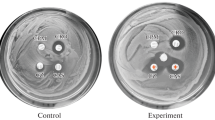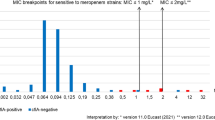Abstract
Rates of resistance to 12 antibiotics were determined for 1,289 isolates of theBacteroides fragilis group submitted in 1988–1989 by 22 laboratories in 15 European countries. There was no resistance to metronidazole (breakpoint 8 mg/l) and only one isolate was resistant to chloramphenicol (breakpoint 8 mg/l). Resistance was uncommon for imipenem (0.3 % at > 4 mg/l), amoxicillin/clavulanate (1 % at > 8 mg/l), cefoxitin (3 % at > 32 mg/l), mezlocillin (6 % at > 64 mg/l) and clindamycin (9 % at > 4 mg/l). Resistance was the rule for ampicillin (93 % at > 4 mg/l), ciprofloxacin (56 % at > 4 mg/l) and tetracycline (64 % at > 4 mg/l).Bacteroides fragilis, the commonest species, was generally the most sensitive: resistance of this organism was uncommon for cefotetan (4 % at > 32 mg/l) and ceftazidime (12 % at > 32 mg/l) to which the other species were more often resistant. There were small but significant differences between laboratories and countries for many of the antibiotics. Regionally the most striking differences were for clindamycin where resistance inBacteroides fragilis was most common in the South and for tetracycline where resistance inBacteroides fragilis, Bacteroides thetaiotaomicron andBacteroides uniformis was least common in the North.
Similar content being viewed by others
References
Phillips I, Eykyn S, Taylor E: Rapid detection of anaerobic bacteria in body fluids. In: Tilton RC (ed): Rapid methods and automation in microbiology. American Society for Microbiology, Washington, DC, 1982, p. 41–44.
Breuil J, Burnat C, Patey O, Dublanchet A: Survey ofBacteroides fragilis susceptibility patterns in France. Journal of Antimicrobial Chemotherapy 1989, 24: 69–75.
Borobio MV, Pascual A, Perea EJ: Increasing resistance ofBacteroides fragilis group strains to metronidazole in Spain between 1977 and 1982. European Journal of Clinical Microbiology 1984, 3: 153–155.
Reig M, Campello MG, Baquero F: Epidemiology of clindamycin resistance in theBacteroides fragilis group. Journal of Antimicrobial Chemotherapy 1984, 14: 595–603.
Garcia-Rodriguez JA, Garcia-Sanchez JE: Evolution of theBacteroides fragilis group antimicrobial susceptibility in Spain. Chemioterapia 1985, 4, Supplement 2: 806–808.
Fox AR, Phillips I: The antibiotic sensitivity of theBacteroides fragilis group in the United Kingdom. Journal of Antimicrobial Chemotherapy 1987, 20: 477–488.
Cuchural GJ, Tally FP, Jacobus NV, Aldridge K, Cleary T, Finegold SM, Iannini P, O'Keefe JP, Pierson C, Crook D, Russo T, Hecht D: Susceptibility of theBacteroides fragilis group in the United States: analysis by site of isolation. Antimicrobial Agents and Chemotherapy 1988, 32: 717–722.
Dubreuil L, Derriennic M, Sedallian A, Romond C, Courtieu AL: Evolution in antibiotic susceptibility ofBacteroides fragilis group strains in France on periodic surveys. Infection 1989, 17: 197–200.
Shannon K, Phillips I: A computer program for the storage and analysis of minimum inhibitory concentrations of antimicrobial agents. Binary 1990, 2: 89–95.
National Committee for Clinical Laboratory Standards: Methods for antimicrobial susceptibility testing of anaerobic bacteria — second edition. Approved Standard M11-A2. NCCLS, Villanova, PA, 1990.
Aldridge KE, Wexler HM, Sanders CV, Finegold SM: Comparison of in vitro antibiograms ofBacteroides fragilis group isolates: differences in resistance rates in two institutions because of differences in susceptibility testing methodology. Antimicrobial Agents and Chemotherapy 1990, 34: 179–181.
Jones RN, Barry AL, Cotton JL, Sutter VL, Swenson JM: Collaborative evaluation of the Micro-Media Systems anaerobe susceptibility panel: comparisons with reference methods and test reproducibility. Journal of Clinical Microbiology 1982, 16: 245–249.
Appelbaum PC, Spangler SK, Jacobs MR: Susceptibilities of 394Bacteroides fragilis, non-B. fragilis groupBacteroides species, andFusobacterium species to newer antimicrobial agents. Antimicrobial Agents and Chemotherapy 1991, 35: 1214–1218.
Betriu C, Campos E, Cabronero C, Rodriguez-Avial C, Picazo JJ: Susceptibilities of species of theBacteroides fragilis group to 10 antimicrobial agents. Antimicrobial Agents and Chemotherapy 1990, 34: 671–673.
Cornick NA, Cuchural GJ, Snydman DR, Jacobus NV, Iannini P, Hill G, Cleary T, O'Keefe JP, Pierson C, Finegold SM: The antimicrobial susceptibility patterns of theBacteroides fragilis group in the United States, 1987. Journal of Antimicrobial Chemotherapy 1990, 25: 1011–1019.
Cuchural GJ, Tally FP, Jacobus NV, Cleary T, Finegold SM, Hill G, Iannini P, O'Keefe JP, Pierson C: Comparative activities of newer β-lactam agents against members of theBacteroides fragilis group. Antimicrobial Agents and Chemotherapy 1990, 34: 479–480.
Bourgault AM, Harding GK, Smith JA, Horsman GB, Marrie TJ, Lamothe F: Survey of anaerobic susceptibility patterns in Canada. Antimicrobial Agents and Chemotherapy 1986, 30: 798–801.
Author information
Authors and Affiliations
Consortia
Additional information
Prof. J.F. Acar, Paris, France; Dr. F. Baquero, Madrid, Spain; Dr. A. Bremmelgaard, Frederiksberg, Denmark; Prof. J.A. Garcia-Rodriguez, Salamanca, Spain; Prof. U. Höffler, Düsseldorf, Germany; Prof. T. Hofstad, Bergen, Norway; Dr. H. Jousimies-Somer, Helsinki, Finland; Prof. N.J. Legakis, Athens, Greece; Prof. D.M. MacLaren, Amsterdam, Netherlands; Dr. P. Maes, Oostende, Belgium; Dr. G.J. Meijer-Severs, Groningen, Netherlands; Dr. H. Mittermayer, Linz, Austria; Prof. C.-E. Nord, Stockholm, Sweden; Prof. G. Panichi, Rome, Italy; Prof. I. Phillips, London, UK; Prof. G. Privitera, Milan, Italy; Dr. A. Sedallian, Annecy, France; Prof. S. Tabaqchali, London, UK; Prof. A. Torres Pereira, Lisbon, Portugal; Prof. U. Ullmann, Kiel, Germany; Prof. J. Wüst, Zurich, Switzerland; Prof. E. Yourassowsky, Brussels, Belgium.
Rights and permissions
About this article
Cite this article
Phillips, I., King, A., Nord, C.E. et al. Antibiotic sensitivity of theBacteroides fragilis group in Europe. Eur. J. Clin. Microbiol. Infect. Dis. 11, 292–304 (1992). https://doi.org/10.1007/BF01962068
Issue Date:
DOI: https://doi.org/10.1007/BF01962068




